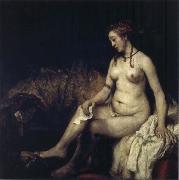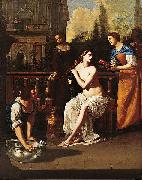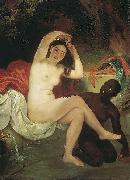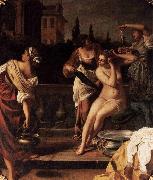Wholesale Oil Painting No Minimum |
|||||||||||
|
|
|||||||||||

|
|||||||||||
|
|
|
||||||||
REMBRANDT Harmenszoon van RijnBorn 1606, Died 1669.One of the great Dutch painters and printmakers of the 17th century, Rembrandt van Rijn is best known for his expressive use of light and shadow (also called chiaroscuro) in his many portraits. Raised in Leiden, he studied with Pieter Lastman (1583-1633) in Amsterdam, then returned to Leiden around 1625 and set up shop as a teacher and portrait artist. Sometime between 1630 and 1632 Rembrandt relocated to Amsterdam, where he spent the rest of his career. Though he had his detractors (some of whom considered him coarse and "low born"), Rembrandt was successful and famous during his lifetime, though he fell on financial hard times in his later years. He was a master printer and produced hundreds of group portraits and historical paintings, including The Anatomy Lesson of Dr. Tulp (1632), The Military Company of Captain Frans Banning Cocq (1642) and Aristotle with a Bust of Homer (1653). His portraits -- including a lifelong trail of intriguing and rather frank self-portraits -- reveal his interest in psychological study and continue to be admired as landmarks in Western art. The Military Company of Captain Frans Banning Cocq is also known as "The Night Watch" because it was thought the painting depicted a nighttime scene. When the painting was cleaned in the 1940s it became obvious that it depicted a daytime scene... He married Saskia van Ulenburgh (also Uylenburgh) in 1634. |
||||||||
|
|
||||||||
Bathsheba
Bathsheba Painting ID:: 34483 |
mk93
1654
Oil on canvas
56x56in
Louvre,Paris
mk93 1654 Oil on canvas 56x56in Louvre,Paris |
|||||||
|
|
||||||||
Artemisia gentileschi1593-1652 was an Italian Early Baroque painter, today considered one of the most accomplished painters in the generation influenced by Caravaggio. In an era when women painters were not easily accepted by the artistic community, she was the first female painter to become a member of the Accademia di Arte del Disegno in Florence. She was one of the first female artists to paint historical and religious paintings, at a time when such heroic themes were considered beyond a woman's reach. Artemisia Gentileschi was born in Rome, July 8, 1593, the first child of the Tuscan painter Orazio Gentileschi, one of the best representatives of the school of Caravaggio. Artemisia was introduced to painting in her father's workshop, showing much more talent than her brothers, who worked alongside her. She learned drawing, how to mix color and how to paint. Since her father's style took inspiration from Caravaggio during that period, her style was just as heavily influenced in turn. But her approach to subject matter was different from her father's, as her paintings are highly naturalistic, where Orazio's are idealized. The first work of the young 17-year-old Artemisia (even if many at the time suspected that she was helped by her father) was the Susanna e i Vecchioni (Susanna and the Elders) (1610, Schönborn collection in Pommersfelden). The picture shows how Artemisia assimilated the realism of Caravaggio without being indifferent to the language of the Bologna school (which had Annibale Carracci among its major artists). It is one of the few Susanna paintings showing the two men planning their sexual harassment. It is likely that Artemisia had been sexually harrassed and painted Susanna as a reflection. In 1612, despite her early talent, Artemisia was denied access to the all-male professional academies for art. At the time, her father was working with Agostino Tassi to decorate the vaults of Casino della Rose inside the Pallavicini Rospigliosi Palace in Rome, so Orazio hired the painter to tutor his daughter privately. During this tutelage, Tassi raped Artemisia. Another man, Cosimo Quorlis had helped Tassi with the rape. After the initial rape, Artemisia continued to have sexual relations with Tassi, with the expectation that they were going to be married. However, Tassi reneged on his promise to marry Artemisia after he heard the rumor that she was having an affair with another man. Quorlis had threatened that if he could not have her, he would publicly humiliate her. Orazio pressed charges against Tassi only after he learned that Artemisia and Tassi were not going to be married. Orazio also claimed that Tassi stole a painting of Judith from the Gentileschi household. The major issue of this trial was the fact that Tassi had deflowered Artemisia. If Artemisia had not been a virgin before Tassi raped her, the Gentileschis would not be able to press charges. In the ensuing 7-month trial, it was discovered that Tassi had planned to murder his wife, had enjoined in adultery with his sister-in-law and planned to steal some of Orazio??s paintings. During the trial Artemisia was given a gynecological examination and was tortured using a device made of thongs wrapped around the fingers and tightened by degrees ?? a particularly cruel torture to a painter. Both procedures were used to corroborate the truth of her allegation, the torture device used due to the belief that if a person can tell the same story under torture as without it, the story must be true. At the end of the trial Tassi was imprisoned for one year. The trial has subsequently influenced the feminist view of Artemisia Gentileschi during the late 20th century. The painting Giuditta che decapita Oloferne (Judith beheading Holofernes) (1612 - 1613), displayed in the Capodimonte Museum of Naples, is impressive for the violence portrayed, and has been interpreted as a wish for psychological revenge for the violence Artemisia had suffered. One month after the trial, in order to restore her honor, Orazio arranged for his daughter to marry Pierantonio Stiattesi, a modest artist from Florence. Shortly afterwards the couple moved to Florence, where Artemisia received a commission for a painting at Casa Buonarroti and became a successful court painter, enjoying the patronage of the Medici family and Charles I. It has been proposed that during this period Artemisia also painted the Madonna col Bambino (The Virgin and Child), currently in the Spada Gallery, Rome. While in Florence, |
||||||||
|
|
||||||||
|
|
Bathsheba
Bathsheba Painting ID:: 87814 |
Date c. 1636(1636)
Medium Oil on canvas
Dimensions 104.5 x 82.5 in (265.4 x 209.6 cm)
cjr Date c. 1636(1636) Medium Oil on canvas Dimensions 104.5 x 82.5 in (265.4 x 209.6 cm) cjr |
||||||
|
|
||||||||
Hans MemlingNetherlandish Northern Renaissance Painter, ca.1435-1494 Born in Seligenstadt, near Frankfurt in the Middle Rhein region, it is believed that Memling served his apprenticeship at Mainz or Cologne, and later worked in the Netherlands under Rogier van der Weyden (c. 1455?C1460). He then went to Bruges around 1465. There is an apocryphical story that he was a wounded at the Battle of Nancy, sheltered and cured by the Hospitallers at Bruges, and that to show his gratitude he refused payment for a picture he had painted for them. Memling did indeed paint for the Hospitallers, but he painted several pictures for them, in 1479 and 1480, and it is likely that he was known to his patrons of St John, prior to the Battle of Nancy. Memling is connected with military operations only in a distant sense. His name appears on a list of subscribers to the loan which was raised by Maximilian I of Austria, to defend against hostilities towards France in 1480. In 1477, when he was incorrectly claimed to have been killed, he was under contract to create an altarpiece for the gild-chapel of the booksellers of Bruges. This altarpiece, under the name of the Seven Griefs of Mary, is now in the Gallery of Turin. It is one of the fine creations of his more mature period. It is not inferior in any way to those of 1479 in the hospital of St. John, which for their part are hardly less interesting as illustrative of the master's power than The Last Judgment which can be found since the 1470s in the St. Mary's Church, Gda??sk. Critical opinion has been unanimous in assigning this altarpiece to Memling. This affirms that Memling was a resident and a skilled artist at Bruges in 1473; for the Last Judgment was undoubtedly painted and sold to a merchant at Bruges, who shipped it there on board of a vessel bound to the Mediterranean, which was captured by Danzig privateer Paul Beneke in that very year. This purchase of his pictures by an agent of the Medici demonstrates that he had a considerable reputation. |
||||||||
|
|
||||||||
|
|
Bathsheba
Bathsheba Painting ID:: 90621 |
1485(1485)
Medium oil on panel
cyf 1485(1485) Medium oil on panel cyf |
||||||
|
|
||||||||
Karl BriullovRussian Neoclassical/Romantic Painter, 1799-1852,was an internationally renowned Russian painter. He is regarded as a key figure in transition from the Russian neoclassicism to romanticism. Born of French parents in Saint Petersburg, Carlo Brulleau (as his name was spelled until 1822) felt drawn to Italy from his early years. Despite his education at the Imperial Academy of Arts (1809?C1821), Briullov never fully embraced the classical style taught by his mentors and promoted by his brother, Alexander Briullov. After distinguishing himself as a promising and imaginative student and finishing his education, he left Russia for Rome where he worked until 1835 as a portraitist and genre painter, though his fame as an artist came when he began doing historical painting. His best-known work, The Last Day of Pompeii (1830?C1833), is a vast composition compared by Pushkin and Gogol to the best works of Rubens and Van Dyck. It created a sensation in Italy and established Briullov as one of the finest European painters of his day. After completing this work, he triumphantly returned to the Russian capital, where he made many friends among the aristocracy and intellectual elite and obtained a high post in the Imperial Academy of Arts. |
||||||||
|
|
||||||||
|
|
Bathsheba
Bathsheba Painting ID:: 91402 |
1832. Oil on canvas. Not finished. 173 x 125.5 cm. cjr 1832. Oil on canvas. Not finished. 173 x 125.5 cm. cjr |
||||||
|
|
||||||||
Artemisia gentileschi1593-1652 was an Italian Early Baroque painter, today considered one of the most accomplished painters in the generation influenced by Caravaggio. In an era when women painters were not easily accepted by the artistic community, she was the first female painter to become a member of the Accademia di Arte del Disegno in Florence. She was one of the first female artists to paint historical and religious paintings, at a time when such heroic themes were considered beyond a woman's reach. Artemisia Gentileschi was born in Rome, July 8, 1593, the first child of the Tuscan painter Orazio Gentileschi, one of the best representatives of the school of Caravaggio. Artemisia was introduced to painting in her father's workshop, showing much more talent than her brothers, who worked alongside her. She learned drawing, how to mix color and how to paint. Since her father's style took inspiration from Caravaggio during that period, her style was just as heavily influenced in turn. But her approach to subject matter was different from her father's, as her paintings are highly naturalistic, where Orazio's are idealized. The first work of the young 17-year-old Artemisia (even if many at the time suspected that she was helped by her father) was the Susanna e i Vecchioni (Susanna and the Elders) (1610, Schönborn collection in Pommersfelden). The picture shows how Artemisia assimilated the realism of Caravaggio without being indifferent to the language of the Bologna school (which had Annibale Carracci among its major artists). It is one of the few Susanna paintings showing the two men planning their sexual harassment. It is likely that Artemisia had been sexually harrassed and painted Susanna as a reflection. In 1612, despite her early talent, Artemisia was denied access to the all-male professional academies for art. At the time, her father was working with Agostino Tassi to decorate the vaults of Casino della Rose inside the Pallavicini Rospigliosi Palace in Rome, so Orazio hired the painter to tutor his daughter privately. During this tutelage, Tassi raped Artemisia. Another man, Cosimo Quorlis had helped Tassi with the rape. After the initial rape, Artemisia continued to have sexual relations with Tassi, with the expectation that they were going to be married. However, Tassi reneged on his promise to marry Artemisia after he heard the rumor that she was having an affair with another man. Quorlis had threatened that if he could not have her, he would publicly humiliate her. Orazio pressed charges against Tassi only after he learned that Artemisia and Tassi were not going to be married. Orazio also claimed that Tassi stole a painting of Judith from the Gentileschi household. The major issue of this trial was the fact that Tassi had deflowered Artemisia. If Artemisia had not been a virgin before Tassi raped her, the Gentileschis would not be able to press charges. In the ensuing 7-month trial, it was discovered that Tassi had planned to murder his wife, had enjoined in adultery with his sister-in-law and planned to steal some of Orazio??s paintings. During the trial Artemisia was given a gynecological examination and was tortured using a device made of thongs wrapped around the fingers and tightened by degrees ?? a particularly cruel torture to a painter. Both procedures were used to corroborate the truth of her allegation, the torture device used due to the belief that if a person can tell the same story under torture as without it, the story must be true. At the end of the trial Tassi was imprisoned for one year. The trial has subsequently influenced the feminist view of Artemisia Gentileschi during the late 20th century. The painting Giuditta che decapita Oloferne (Judith beheading Holofernes) (1612 - 1613), displayed in the Capodimonte Museum of Naples, is impressive for the violence portrayed, and has been interpreted as a wish for psychological revenge for the violence Artemisia had suffered. One month after the trial, in order to restore her honor, Orazio arranged for his daughter to marry Pierantonio Stiattesi, a modest artist from Florence. Shortly afterwards the couple moved to Florence, where Artemisia received a commission for a painting at Casa Buonarroti and became a successful court painter, enjoying the patronage of the Medici family and Charles I. It has been proposed that during this period Artemisia also painted the Madonna col Bambino (The Virgin and Child), currently in the Spada Gallery, Rome. While in Florence, |
||||||||
|
|
||||||||
|
|
Bathsheba
Bathsheba Painting ID:: 95453 |
first half of 17th century
Medium oil on canvas
cyf first half of 17th century Medium oil on canvas cyf |
||||||
|
|
||||||||
|
Artemisia gentileschi 1593-1652 was an Italian Early Baroque painter, today considered one of the most accomplished painters in the generation influenced by Caravaggio. In an era when women painters were not easily accepted by the artistic community, she was the first female painter to become a member of the Accademia di Arte del Disegno in Florence. She was one of the first female artists to paint historical and religious paintings, at a time when such heroic themes were considered beyond a woman's reach. Artemisia Gentileschi was born in Rome, July 8, 1593, the first child of the Tuscan painter Orazio Gentileschi, one of the best representatives of the school of Caravaggio. Artemisia was introduced to painting in her father's workshop, showing much more talent than her brothers, who worked alongside her. She learned drawing, how to mix color and how to paint. Since her father's style took inspiration from Caravaggio during that period, her style was just as heavily influenced in turn. But her approach to subject matter was different from her father's, as her paintings are highly naturalistic, where Orazio's are idealized. The first work of the young 17-year-old Artemisia (even if many at the time suspected that she was helped by her father) was the Susanna e i Vecchioni (Susanna and the Elders) (1610, Schönborn collection in Pommersfelden). The picture shows how Artemisia assimilated the realism of Caravaggio without being indifferent to the language of the Bologna school (which had Annibale Carracci among its major artists). It is one of the few Susanna paintings showing the two men planning their sexual harassment. It is likely that Artemisia had been sexually harrassed and painted Susanna as a reflection. In 1612, despite her early talent, Artemisia was denied access to the all-male professional academies for art. At the time, her father was working with Agostino Tassi to decorate the vaults of Casino della Rose inside the Pallavicini Rospigliosi Palace in Rome, so Orazio hired the painter to tutor his daughter privately. During this tutelage, Tassi raped Artemisia. Another man, Cosimo Quorlis had helped Tassi with the rape. After the initial rape, Artemisia continued to have sexual relations with Tassi, with the expectation that they were going to be married. However, Tassi reneged on his promise to marry Artemisia after he heard the rumor that she was having an affair with another man. Quorlis had threatened that if he could not have her, he would publicly humiliate her. Orazio pressed charges against Tassi only after he learned that Artemisia and Tassi were not going to be married. Orazio also claimed that Tassi stole a painting of Judith from the Gentileschi household. The major issue of this trial was the fact that Tassi had deflowered Artemisia. If Artemisia had not been a virgin before Tassi raped her, the Gentileschis would not be able to press charges. In the ensuing 7-month trial, it was discovered that Tassi had planned to murder his wife, had enjoined in adultery with his sister-in-law and planned to steal some of Orazio??s paintings. During the trial Artemisia was given a gynecological examination and was tortured using a device made of thongs wrapped around the fingers and tightened by degrees ?? a particularly cruel torture to a painter. Both procedures were used to corroborate the truth of her allegation, the torture device used due to the belief that if a person can tell the same story under torture as without it, the story must be true. At the end of the trial Tassi was imprisoned for one year. The trial has subsequently influenced the feminist view of Artemisia Gentileschi during the late 20th century. The painting Giuditta che decapita Oloferne (Judith beheading Holofernes) (1612 - 1613), displayed in the Capodimonte Museum of Naples, is impressive for the violence portrayed, and has been interpreted as a wish for psychological revenge for the violence Artemisia had suffered. One month after the trial, in order to restore her honor, Orazio arranged for his daughter to marry Pierantonio Stiattesi, a modest artist from Florence. Shortly afterwards the couple moved to Florence, where Artemisia received a commission for a painting at Casa Buonarroti and became a successful court painter, enjoying the patronage of the Medici family and Charles I. It has been proposed that during this period Artemisia also painted the Madonna col Bambino (The Virgin and Child), currently in the Spada Gallery, Rome. While in Florence, Bathsheba first half of 17th century Medium oil on canvas cyf |
||||||||
|
|
||||||||
|
Prev Next
|
||||||||
|
|
||||||||
|
Related Paintings to Artemisia gentileschi :. |
||||||||
|
|
||||||||
|
CONTACT US |





